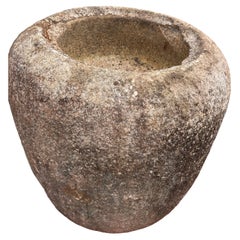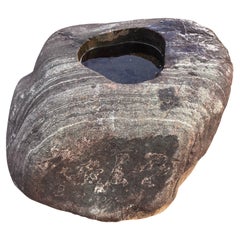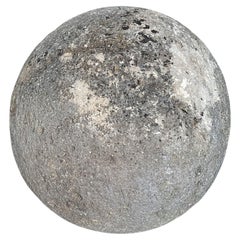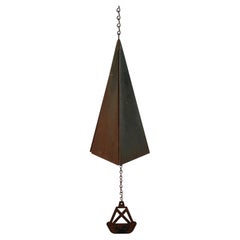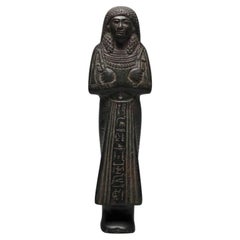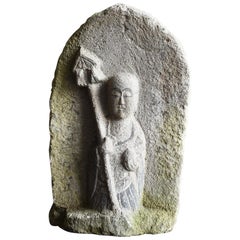Granite More Asian Art, Objects and Furniture
to
2
2
2
2
2
1,280
822
673
364
170
2
2
2
2
2
2
Material: Granite
Japan, Large Old Hand-Carved Tsukubai Water Basin "Natsume"
Located in South Burlington, VT
Japan a beautiful large hand carved Tsukubai Water Basin "Natsume" (tea container) shape, granite, Taisho period (1915).
Please view our video.
Dimensions: 29 inches tall and 26 in...
Category
Early 20th Century Japanese Taisho Granite More Asian Art, Objects and Furniture
Materials
Granite
$2,765 Sale Price
30% Off
Japan, Large Smooth Rare Red Stone Water Basin Tsukubai
Located in South Burlington, VT
Japan a stunningly beautiful large hand carved Tsukubai Water Basin crafted from a rare red striped kurama granite. Kurama granite is no longer accessible in Japan and so this repre...
Category
Early 20th Century Japanese Taisho Granite More Asian Art, Objects and Furniture
Materials
Granite
$2,240 Sale Price
20% Off
Related Items
Large 19th Century Stone Sphere
Located in Vosselaar, BE
Stone spheres as these where made from antiquity to the present day. As a universal form it served as a ornamental object in gardens, architecture and interiors but also had a deeper...
Category
Mid-19th Century French Antique Granite More Asian Art, Objects and Furniture
Materials
Stone
Japanese Hand Made Garden Wind Chime
Located in Douglas Manor, NY
Japanese hand made garden wind chime.
Category
Mid-20th Century Granite More Asian Art, Objects and Furniture
Materials
Iron
Antique Large Oriental Japanese Chinese Bronze Champleve Enamel Jardiniere Meiji
Located in Wisbech, Cambridgeshire
Antique large quality Oriental Japanese chinese bronze champleve enamel Jardiniere planter bowl C1920.
Would look amazing in the right location. Rare la...
Category
1920s Japanese Vintage Granite More Asian Art, Objects and Furniture
Materials
Bronze
$1,235 Sale Price
30% Off
H 11.82 in Dm 13 in
Very Rare Brass Watering Can with Movable Spider, 1950s, Austria
Located in Nürnberg, Bayern
Very rare brass watering can with a small spider as decoration.
Category
1950s Austrian Mid-Century Modern Vintage Granite More Asian Art, Objects and Furniture
Materials
Brass
$1,600
H 7.09 in W 5.32 in D 16.93 in
Marble Scalloped Sink Basin
Located in Cranbrook, Kent
Classical Italian scalloped sink basin cut from one single block of Carrara marble.
Custom sizes available
Category
21st Century and Contemporary Italian Classical Roman Granite More Asian Art, Objects and Furniture
Materials
Marble
Old Japanese Decagonal White Glaze Bowl / 1926-1970 / Coffee Cup
Located in Sammu-shi, Chiba
A bowl with a beautiful white glaze.
Probably made in the Showa period (1926-1970).
The decagonal shape gives a tighter impression than the circular shape.
It is nice to use it ...
Category
20th Century Japanese Showa Granite More Asian Art, Objects and Furniture
Materials
Pottery
Japanese Tabako-bon with Two Rabbits, c. 1920
Located in Chicago, IL
This wooden box is a Japanese tabako-bon, or 'tobacco tray,' used to store tobacco and smoking accessories. Believed to have evolved from the traditional ...
Category
Early 20th Century Japanese Taisho Granite More Asian Art, Objects and Furniture
Materials
Bamboo, Bakelite, Hardwood
Classical Marble Carved Stone Sink Basin
Located in Cranbrook, Kent
Classical Italian sink basin cut from one single block of white marble with serpentine shaped front and gadrooned carving, these Greek/Roman designs quite happily suit either old or ...
Category
21st Century and Contemporary Italian Classical Roman Granite More Asian Art, Objects and Furniture
Materials
Carrara Marble
Japanese Edo Period Kannon Stone Buddha/1700-1850/Garden Ornament
Located in Sammu-shi, Chiba
We are pleased to present a simple stone Buddha of Kannon Bosatsu, made in Japan during the Edo period (circa 1700-1850).
Kannon Bosatsu is known in Buddhism as a merciful savior wh...
Category
18th Century Japanese Edo Antique Granite More Asian Art, Objects and Furniture
Materials
Stone, Granite
Chinese Paktong Basin, 19th Century
Located in Lymington, Hampshire
A Chinese paktong basin, engraved with scenes of many children at play and before pagodas, within borders of shou characters, bats and flowerheads, the flattened rim with vases of flowers and lingzhi, swords, lotus pods...
Category
19th Century Japanese Meiji Antique Granite More Asian Art, Objects and Furniture
Materials
Metal
Large Japanese Imari Vase
Located in West Palm Beach, FL
A large Japanese Imari vase
Of baluster form with a long narrow neck enameled in underglaze blue and iron red with catfish and flowers; signed.
M...
Category
20th Century Granite More Asian Art, Objects and Furniture
Materials
Ceramic
Japanese antique stone basin "Tsukubai" / Garden ornament / 1868-1920
Located in Sammu-shi, Chiba
This is an old tsukubai (stone basin) believed to have been made in Japan.
In Japanese culture, there is a long-standing tradition of designing gardens that reflect the changing bea...
Category
Late 19th Century Japanese Meiji Antique Granite More Asian Art, Objects and Furniture
Materials
Stone
$800
H 4.89 in W 15.95 in D 12.01 in
Previously Available Items
Ushabti of 'Kenj'
Located in London, GB
The XIX Dynasty of Ancient Egypt was part of the Egyptian New Kingdom and was founded by Vizier Ramasses I, whom Pharaoh Horemheb chose as his successor to the throne. The XIX Dynasty is best remembered for its military conquests in the lands of Canaan. The relative peace of the XVIII Dynasty gave way to a century of wars, which produced art that attempted to maintain ancestral traditions in order to claim its dynastic lineage and succession to the throne.This large serpentine statue tells of the prominence of administrative art during this period. The figure is an ushabti, a funerary statue that would have been placed in a tomb among the grave goods of the inhabitant, intended to act as a servant for the deceased in the afterlife. The ushabtis would be called upon to perform their menial tasks, each figure's purpose is often attested to by objects in their hands, such as bread-baker holding grain or farmer holding a scythe, and they would be donated by the workers of the deceased to fulfill their roles for them in death. Hieroglyphics could often also be found running the length of their legs giving further clues to their roles and stating whom they intended to work for. These inscriptions were called answers and asserted the figures readiness to be summoned to the gods work The practice of placing ushabtis inside tombs originated in the Old Kingdom, with the earliest evidence from the middle of the third millennium B.C. when they buried next to mummies[2]. They are normally miniature in size, of hard stones such as limestone, granite or serpentine (and occasionally of faience or bronze), and produced in multiples to provide the important deceased with an army of workers. Sometimes so many were produced that they world cover the entire surface floor of a tomb. Due to this commonness, many extant examples survive, in varying qualities, and as a collection of artifacts they provide a unique insight in to the fascinating death customs of the Ancient Egyptians, highlighting their very real belief in an eternal afterlife.This beautifully carved statue holds hoes and a seed sack, indicating they were destined for manual toil in the eternal afterlife amongst the fields growing grain to produce food for the interred. Another agricultural implement with crisscrossing ropes is tucked in to the back of the figure's kilt, making sure he is ready for any farming situation necessary. He wears a long-sleeved shirt with a long pleated kilt, which has a large over-fold and broad beaded collar. He also wears a double wig composed of zig-zags and echeloned curls, and his face has a slightly aquiline nose, with almond-shaped eyes a fixed, determined gaze.A column running the length of his over-fold contains five lines of hieroglyphic inscription that name the owner of the worker (Kenj), and recite chapter VI from the Ancient Egyptian Book of...
Category
15th Century and Earlier Egyptian Antique Granite More Asian Art, Objects and Furniture
Materials
Granite
1800s Edo Period Japanese Stone Jizo Bodhisattva or Colored Buddha Statue
Located in Sammu-shi, Chiba
We Japanese introduce unique items with unique aesthetics, purchasing routes, and ways that no one can imitate.
It is an old Japanese stone Buddha...
Category
19th Century Japanese Edo Antique Granite More Asian Art, Objects and Furniture
Materials
Granite
H 17.33 in W 10.24 in D 7.88 in
Japanese Stone Buddha Statue 'Nyorai' 1700-1800 Middle-Late Edo Period
Located in Sammu-shi, Chiba
We Japanese introduce unique items with unique aesthetics, purchasing routes, and ways that no one can imitate.
This is a stone Buddha from the middle to late Edo period.
Tathagata, called Amida...
Category
18th Century Japanese Edo Antique Granite More Asian Art, Objects and Furniture
Materials
Granite
Japan Tea Lantern Hand-Carved Granite Perfect Indoor or Outdoor
Located in South Burlington, VT
Japan, a fine easily portable hand-carved granite stone tea lantern with square roof measures 24 inches high and 13 inches wide, Showa period 1940s-1950s.
Carved from solid granite by Japanese specialized artisans over 50 years ago. This is a handsome example, a little gem in this simple convenient and portable size.
The striking and well proportioned hand-carved sculpture as an Oribe
style lantern fashioned in four parts from granite as roof kasa and light chamber/base Hibukuro/kiso all with patina. Furuta Oribe (1544 – July 6, 1615), influenced this design- a style of stone lantern for the roji tea garden, known as Oribe-doro.
Provenance: Old Kyoto Prefecture garden- this is an authentic Japanese carved lantern.
Handmade perfect portable garden size.
Many of our customers place oil candles inside the main section making a romantic and enjoyable decorative accent for entertaining friends and family. It's a perfect choice for your indoor or outdoor garden space.
Lifetime guarantee of authenticity: All of our Asian works of art come with our Lifetime Authenticity Guarantee.
History of Japanese lanterns:
In Japan a to¯ro¯ (lantern) is a traditional lantern made of stone, wood, or metal. Like many other elements of Japanese traditional architecture, it originated in China. In Japan, to¯ro¯ were originally used only in Buddhist temples, where they lined and illuminated paths and lighted lanterns were then considered an offering. In its complete, original form the lantern represents five elements of Buddhist cosmology: Bottom touching the ground, represents chi, the earth, the next section represents sui, or water, ka or fire, is represented by the section encasing the lantern's light or flame, while fu¯ (air) and ku¯ (void or spirit) are represented by the last two sections, top-most and pointing towards the sky. These last two sections express the idea that after death our physical bodies will go back to their original, elemental form.
Furuta Oribe (1544 – July 6, 1615), whose birth name was Furuta Shigenari (?? ??), was a daimyo and celebrated master of the Japanese tea ceremony. His teacher in the tea ceremony was Sen no Rikyu. He became the foremost tea master in the land after Rikyu's death, and taught this art to the shogun Tokugawa Hidetada. Among his other particularly famous tea ceremony students were Kobori Enshu and Honami Koetsu...
Category
20th Century Japanese Showa Granite More Asian Art, Objects and Furniture
Materials
Granite
Japan Antique Stone Lantern "Yukimi" Hand-Carved Classic Water and Snow
Located in South Burlington, VT
From our recent Japanese acquisitions travels.
Japan, a fine larger scale early Classic "yukimi" lantern hand-carved in granite stone.
Dimensions: This is a larger scale exampl...
Category
1890s Japanese Meiji Antique Granite More Asian Art, Objects and Furniture
Materials
Granite
Japan Antique Stone Lantern "Yukimi" Hand-Carved Classic Water or Snow Lantern
Located in South Burlington, VT
From our Recent Japanese Acquisitions Travels.
Japan, a fine early Classic "yukimi" lantern hand-carved in granite stone,
34 inches high and 31 inches wide at top, four pieces.
19t...
Category
1890s Japanese Meiji Antique Granite More Asian Art, Objects and Furniture
Materials
Granite
H 34 in W 31 in D 31 in
Japan Extraordinary Large Old Natural Solid Stone Tsukubai Water Basin
Located in South Burlington, VT
Japan a beautiful large and natural formed tsukubai water basin in an unusual attractive contemporary shape, solid smooth limestone.
Dimensions: 26 inches tall and 26 inches wide an...
Category
Early 20th Century Japanese Taisho Granite More Asian Art, Objects and Furniture
Materials
Granite
Japan, Large Old Hand-Carved Tsukubai Water Basin "Natsume"
Located in South Burlington, VT
Japan a beautiful large hand carved Tsukubai Water Basin "Natsume" (tea container) shape, granite, Taisho period (1915).
Dimensions: 31 inches tall and 28 inches diameter at top
...
Category
Early 20th Century Japanese Taisho Granite More Asian Art, Objects and Furniture
Materials
Granite
Japanese Antique Stone Lantern
Located in South Burlington, VT
Japan “Yukimi” granite stone lantern (also known as a "snow" lantern" because of its broad roof- see photo), four pieces, Measures: 28 inches high and 28 inches wide, Taisho period, 1912-1926. A beautiful example carved in Fine quality granite. Fine quality suited for the finest garden.
History of Yukimi lantern:
Yukimi-do¯ro¯ (?????) or legged lanterns have as a base not a post but from one to six curved legs, and a wide umbrella with a finial either low or absent. Relatively low, they are used exclusively in gardens. The traditional placement is near water, and a three-legged lantern will often have two legs in the water, and one on land but today they enjoy wide spread popularity placed in many different settings and in many different styles of gardens. The umbrella can be round or have from three to eight sides, while the fire box is usually hexagonal.
Yukimi denotes water reflection.
It was probably developed during the Momoyama period, but the oldest extant examples, found at the Katsura Villa in Kyoto, go back only to the early Edo period (17th century). (Thank you wikpedia)
Provenance: Old Nagoya garden.
Schneible Fine Arts has been dealing in authentic Japanese antique...
Category
Early 20th Century Japanese Taisho Granite More Asian Art, Objects and Furniture
Materials
Granite
Japanese Antique Hand-Carved Granite Temple Lotus Lantern Meiji Era
Located in South Burlington, VT
A Japanese antique hand-carved granite temple Lotus Lantern, Meiji era (1868-1912)
This the first example of this hard to find round -maru- temple style ...
Category
19th Century Japanese Meiji Antique Granite More Asian Art, Objects and Furniture
Materials
Granite
Fine Japanese Antique Classic Hand carved Stone Garden Planter Water Basin, 29"h
Located in South Burlington, VT
Two left for summer 2018
Japan, a visually attractive large antique classic stone garden tsukubai, planter or water basin natsume (tea canister shape) which was hand-carved from solid granite. Fine old patina.
Whether you install flowers, leafy vines, succulents, stones , or floating flowers in glistening water- this iconic shaped stone basin will never cease to amaze.
Just two of these stone basins currently left in our inventory for summer 2018
Dimensions: 29 inches high and 24 inches diameter
Period: hand-carved in solid granite during the Meiji to -Showa periods, (1890-1940).
Comments: The handsome and well proportioned hand-carved form known as natsume (tea canister shape) fashioned in solid granite stone and
featuring varied patina from age. These are extraordinary works of art for fine gardens. Quintessential Japanese planter form ready for your flowers, hanging vines, or superb water features.
Please see photographs of numerous ways you can display and decorate these quintessential Japanese stone basins...
Category
Early 20th Century Japanese Taisho Granite More Asian Art, Objects and Furniture
Materials
Granite
H 29 in W 24 in D 24 in
Lovely Japanese Hand-Carved Red Kurama Stone Water or Plant Basin One-of-a-kind
Located in South Burlington, VT
A genuine rarity, this fine large sized old hand-carved solid granite stone water or plant basin in a rustic style, is hand caved from a rare red colored (iron rich) granite stone ca...
Category
20th Century Japanese Granite More Asian Art, Objects and Furniture
Materials
Granite
H 17 in W 34 in D 28 in
